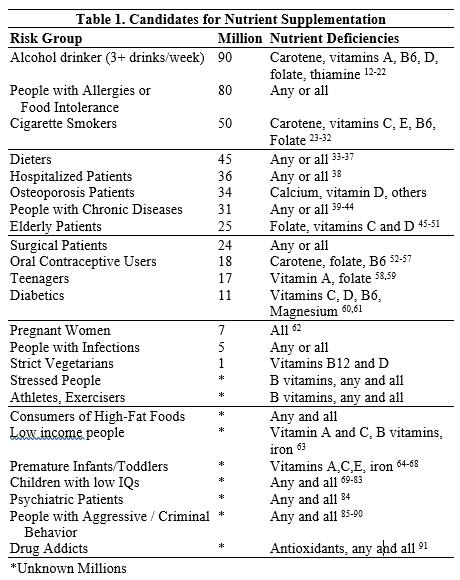1/6/16
We do not diagnose disease or recommend a dietary supplement for the treatment of disease. You should share this information with your physician who can determine what nutrition, disease and injury treatment regimen is best for you. You can search this site or the web for topics of interest that I may have written (use Dr Simone and topic).
“We provide truthful information without emotion or influence from the medical establishment, pharmaceutical industry, national organizations, special interest groups or government agencies.” Charles B Simone, M.MS., M.D.
MARGINAL VITAMIN DEFICIENCIES – Excerpt from CANCER AND NUTRITION (1980, revised 2007), C B Simone MD
Lawrenceville, NJ (Dr Simone) – This Report and a few more are written because of two recent discussions I had.
-
Two high ranking officers of a large health insurance company indicated that healthy food was more expensive than less healthy food and that was an important reason for poor health especially in indigent groups – this is wrong. Healthy food is less expensive than fast food and less healthy food.
-
Some people say they feel better when they take Product XYZ, even though on close inspection by me the product has low levels of vitamins and minerals. The reason for this “good feeling” is because most people have MARGINAL VITAMIN DEFICIENCIES and even small doses will help those people.
We know that nutritional factors are responsible for 60% of women’s cancers, 40% of men’s cancers, 80% of cardiovascular disease, obesity, and diabetes.
A person who is grossly deficient in vitamins demonstrates specific symptoms and complaints. But a person with only marginal deficiencies demonstrates no such signs or symptoms and does not appear to be ill.
Do you consider your diet to be well balanced? Do you think it is meeting your nutritional needs? Although you may believe it is fulfilling your requirements, you will most likely find that your diet is deficient in at least one nutrient. Consider the following:
USDA Study published in 2005 showed that certain foods have 14% to 400% less vitamin levels when compared to the same foods in 1975.
MARGINAL DEFICIENCIES
Marginal deficiency is a gradual vitamin depletion in which there is evidence of personal lack of well-being associated with impairment of certain biochemical reactions. The person may complain of non-specific symptoms such as fatigue, decreased mental acuity, loss of appetite, irritability, inability to sleep, and decreased resistance to disease, infection, as well as poor wound healing. Comprehensive studies including the federally sponsored HANES studies, confirm marginal deficiencies by measuring blood levels or assessing dietary ingestion. About 50 percent of all people examined and surveyed, whether rich or poor, educated or not, had at least one, and usually two or three marginal nutrient deficiencies.
LIFESTYLE AND EATING PATTERNS
Lifestyle and eating patterns can lead to nutrient deficiencies. There is an increased demand for convenience foods and fast-food. Eating patterns have changed. About 25% of Americans skip breakfast, 25% skip lunch, almost 50% snack, and most eat one meal a day away from home. In 1965 affluent whites ate less healthy compared to poor African-Americans; by 1991, the diets of both were similar.
In the federally sponsored HANES II study, people were asked to choose a food that they liked and considered “balanced.” For a “balanced” vegetable, the majority chose French fries over broccoli; for meat/legume, hot dogs over split peas; and for grain, white bread over whole wheat. In the same study, favorite foods included coffee, doughnuts, soft drinks, and hamburgers. The percentage of calories in the American diet derived from fat is 42; from sugar, 24.
When caloric intakes fall below 1,600 calories, most nutritional guidelines cannot be met. And below 1,800 per day, which about 50% of the population consumes at times, trained nutritionists have trouble designing meals to provide the minimum RDIs. The Nationwide Food Consumption Survey found that over 50% of people who thought they ate the “well-balanced” diet had deficiencies in vitamins A, C, B1, B2, B6, B12, calcium, magnesium, and iron. Women of all economic levels had low intakes of vitamins A, C, B6, calcium, iron, and zinc.
Outright vitamin deficiencies occur in two groups of people. In the first group, people are unable to buy the right kinds of food because they are not knowledgeable about the proper foods. The second group consists of people whose nutrient deficiency occurs as the result of a specific disease or a drug or other treatment therapy.
Americans unknowingly eat foods that Genetically Modified or are sprayed with chemicals, refined, processed, over-cooked, frozen, canned, stored, and trucked around the country. Many of our meats contain the hormones and chemicals that have been fed to animals. All of these foods have been depleted of nutrients to varying degrees. Some methods of cooking can totally destroy nutrients or decrease their concentration, and some nutrients are not stable in heat or boiling water. As a result, Americans do not or cannot eat a healthful balanced diet.
We get about one-third of our calories from sources of little or no nutrient value. The average American consumes about 60 pounds of sugar each year and four to five times the amount of salt necessary, favors carbonated drinks to others when not consuming 2.6 gallons of alcoholic beverages each year (if of drinking age). In short, it is very difficult to find an individual who consistently, on a daily basis, eats a “well-balanced diet” – that is, one containing foods that are freshly prepared, varied, and nutritionally adequate.
GROUPS AT RISK FOR NUTRIENT DEFICIENCIES
There are multiple groups of our population that may not be “healthy” and that may be considered to be “at risk” for inadequate nutrient intake. The RDIs do not take into account the special needs of these people. The greater requirements of the groups listed in Table 1 need to be recognized and addressed.

Even though you try to eat well, it is virtually impossible to obtain the proper doses of vitamins and minerals from the current foods.
(c) 2017 Charles B. Simone, M.MS., M.D.




